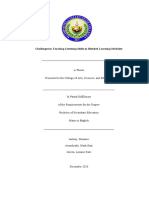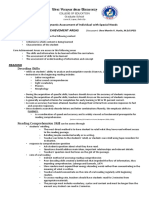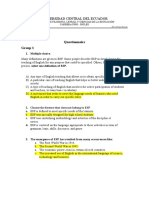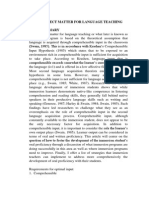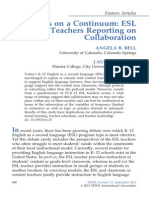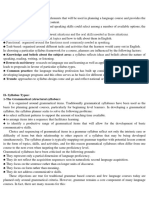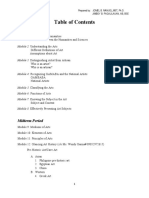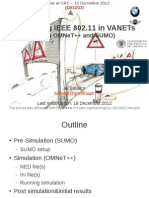Situational Analysis
Uploaded by
Merbai MajdaSituational Analysis
Uploaded by
Merbai Majda- Situational Analysis
The analysis of the context situation is another important step in curriculum development
planning. The order of its appearance in the sequence plan is not hierarchical. It is even considered
by some authors as a part of needs analysis that investigates the various factors that might foster or
hinder the success of the implementation of a given curriculum. Graves (2000:29) claims: “the
givens of a context are the resources and constraints that guide our decisions. She further claims
that knowing how long a course is, its purpose, who the students are, and how it fits in with other
aspects of the curriculum helps us to make decisions about content, objectives and so on. Graves
(2000:30) views the analysis of the context situation as part of pre-course needs assessment.
“Information about the students and about the curriculum is clearly related to students’ learning
needs” .Other information such as time and setting does not necessarily help define students’
learning needs, but has to be taken into account in order to design a course that can focus on the
needs with the givens of the context. Graves (2000), refers to the analysis of the context situation
as ‘problematizing’ to mean: “looking at what you know about the context and defining the
challenges you feel you need to and are able to meet in order to make the course successful. These
challenges may involve class size, multi-levels, number of hours, lack of resources, your own lack
of experience with the content of the course, and so on” (p.32). She further states that
problematizing helps to decide where to start and what to focus on in the course. “The more
apparent the challenges will be, and the better you will be able to define and address the challenges
as you design and teach the course”. It is about “making choices for action” (p.33).For practical
considerations, Graves (2000) summarizes the various aspects of context that one can define:
people, time, physical setting, teaching resources, and nature of the course and institution.
The people to consider in analyzing the context situation are mainly the students (how many,
age, gender, culture(s), other language(s), purpose(s), education, profession, experience), and other
stakeholders including school administrators, parents, funders, and the community at large.
Analyzing time would require the examination of the number of hours over a given span of time,
the identification of how often the class meets and for how long each time in addition to the day of the
week and the time of the day and where it fits in the students’ schedule and timeliness.
For Graves (2000), the physical setting refers to the school’s location, convenience, setting, classroom
furniture, light, and noise.
Teaching resources refer to the available materials (whether a textbook is required or the
development of teachers’ own materials is recommended), and the equipment including cassettes,
videos, photocopying, and clerical support.
The analysis of the nature of the course and institution would require gathering data about
the type of the course (whether mandatory, open enrolment), its relation to current/previous
courses, in addition to recognizing whether the curriculum is prescribed or not and whether it
requires tests or not.
Richards (2001:91) refers to it as situation analysis and defines it as “an analysis of factors
in the context of a planned or present curriculum project that is made in order to assess their
potential impact on the project. These factors may be: social, economic, institutional, or political”.
For Richards, situational analysis complements the information gathered during needs analysis
(sometimes considered as a dimension of needs analysis). It can even be considered as an aspect of
evaluation. Language programs are carried out in particular contexts or situations. About this point,
Clark (1987 cited in Richards 2001:90) comments: “A language curriculum is a function of the
interrelationships that hold between subject specific concerns and other broader factors embracing
socio-political and philosophical matters, educational value systems, theory and practice in
curriculum design, teacher experiential wisdom, and learner motivation. In order to understand the
foreign language curriculum in any particular context, it is therefore necessary to attempt to
understand how all the various influences interrelate to give a particular shape to the planning and
execution of the teaching/learning process”.
The success of a program depends largely on the diverse contexts and the particular variables
that come into play in a specific situation. Richards (2001) provides the example of curricula that
are planned for organised state school systems where a great deal of direction and support for
teaching is provided and some others take place in settings where there are limited human and
physical resources. He adds that some proposals for curriculum change are well received by
teachers while others may be resisted. Besides, in some situations, teachers are well trained and
have time available to plan their own lesson materials; in other situations, teachers may have little
time for lesson planning and materials production and simply teach from their textbooks. The
examples mentioned above demonstrate that each context for a curriculum contains factors that can
potentially facilitate the change or hinder the successful implementation. It is important therefore,
to identify what these factors are and what their potential effects might be when planning a
curriculum. For Richards (2001), the designer should estimate both the direct and indirect effects
a proposed curriculum will have on the student, on other programs, and on other people in and
outside the institution. These effects must be taken into account in the design and made clear to
decision makers when the curriculum proposal is submitted. He refers to relevant factors through
which the curriculum design planner(s) may investigate the potential obstacles that might hinder
the successful implementation of the planned curriculum. The factors are namely; societal (to
determine the impact of groups in the community or society at large on the program, including
policy makers in government, employers, parents, citizens...), project factors (time, resources ,and
personnel), institutional factors (both human and physical), teacher factors (language proficiency,
teaching experience, skill and expertise, training and qualifications, morale and motivation,
teaching style, beliefs and principles), learner factors (past language learning experiences,
motivation, expectations from the program, learning approaches, preferred content, time expected
to be put into the program, resources they have access to), and adoption factors ( the relative ease
or difficulty of introducing change into the system). Richards refers to situation analysis as SWOT
analysis. It examines “language program’s internal strengths and weaknesses in addition to external
opportunities and threats to the existence or successful operation of the language program”
(Klinghammer 1997:.65, cited in Richards 2001: 105-106).
On the other hand, Mc Calister & Nation (2005) qualify the analysis of context situation as
environment analysis, and define it similarly as involving looking at the factors that will have a
strong effect on decisions about the goals of the course, what to include in the course, and how to
teach and assess it. These factors can arise from the learners, the teachers and the teaching and
learning situation. They also confirm that in some curriculum models, environment analysis is
included in needs analysis. They consider that there are many factors that could affect curriculum
design, so as part of the procedure of environment analysis, the curriculum designer should decide
which factors are the most important. The importance of a factor depends on: Whether the course
will still be useful if the factor is not taken into account, and how large and pervasive the effect of
the factor is on the course. Still further, Mc Calister & Nation (2005) see that it is sometimes
necessary to consider wider aspects of the situation when carrying out an environment analysis (for
example, institutional or government policies requiring the use of the target language in schools,
or the negative attitudes towards the target language among learners in post- colonial societies).
They suggest making use of Dubin and Olshtain’s (1986) model of sources of information for
language program policy which includes the language setting, patterns of language use in society,
political and national context, group and individual attitudes. The model states that the answers to
these questions determine policy: who are the learners? Who are the teachers? Why is the program
necessary? Where will the program be implemented? How will it be implemented?
Mc Calister and Nation (2005) suggest that conducting context situation analysis can follow the
following steps:
1. Brainstorm and then systematically consider the range of environment factors that will affect the
course
2. Choose the most important factors (no more than five) and rank them, putting the most important
first
3. Decide what information you need to fully take account of the factor. The information can come
from investigation of the environment and from research and theory.
4. Consider the effects of each factor on the design of the course.
5. Go through steps 1,2,3 and 4 again.
According to Richards (2001), they are similar to those involved in needs analysis namely:
Consultation with representatives of as many relevant groups as possible (parents, students,
teachers, administrators, government officials), study and analysis of relevant documents
(guidelines, government reports, policy papers, teaching materials, curriculum
documents…),observation of teachers and students in relevant learning settings, surveys of
opinions of relevant parties, and review of available literature related to the issue.
In sum, as Richards (2001) points out “context situation analysis serves to help identify
potential obstacles to implementing a curriculum project and factors that need to be considered
when planning the parameters of a project”.
You might also like
- Parker Et Al 2023 Chatgpt For Automated Writing Evaluation in Scholarly Writing InstructionNo ratings yetParker Et Al 2023 Chatgpt For Automated Writing Evaluation in Scholarly Writing Instruction7 pages
- Challenges in Teaching Listening Skills in Blended Learning ModalityNo ratings yetChallenges in Teaching Listening Skills in Blended Learning Modality14 pages
- Daily Lesson Plan English Language Year 2 Date / Day Time / Class Focus Theme Topic Content Standard Learning Standard Learning ObjectivesNo ratings yetDaily Lesson Plan English Language Year 2 Date / Day Time / Class Focus Theme Topic Content Standard Learning Standard Learning Objectives5 pages
- Keynote Proficient Final Exam Grammar 10aNo ratings yetKeynote Proficient Final Exam Grammar 10a2 pages
- Best Practices English-Grade 7 Recitation ChipsNo ratings yetBest Practices English-Grade 7 Recitation Chips2 pages
- Using Word Parts To Determine The Meaning of Words: Learning ObjectivesNo ratings yetUsing Word Parts To Determine The Meaning of Words: Learning Objectives2 pages
- Arab EFL University Students - Errors in The Use of Prepositions by Yousef Sharif Tahaineh Pages 76-1120% (1)Arab EFL University Students - Errors in The Use of Prepositions by Yousef Sharif Tahaineh Pages 76-11237 pages
- An Analysis of Students' Reading Comprehension Based On The Four Levels Comprehension Skills (A Study at The Second Year Students of SMAN 10 Bengkulu Academic Year 2014/2015)No ratings yetAn Analysis of Students' Reading Comprehension Based On The Four Levels Comprehension Skills (A Study at The Second Year Students of SMAN 10 Bengkulu Academic Year 2014/2015)20 pages
- Current Perspectives On Teaching The Four SkillsNo ratings yetCurrent Perspectives On Teaching The Four Skills24 pages
- Cognitive Strategies and Listening ComprehensionNo ratings yetCognitive Strategies and Listening Comprehension8 pages
- Syllabus Principles and Theories of Language100% (1)Syllabus Principles and Theories of Language11 pages
- Language in Society: Lady Lou C. Pido, MaltNo ratings yetLanguage in Society: Lady Lou C. Pido, Malt39 pages
- Brown - Identifying and Describing ErrorsNo ratings yetBrown - Identifying and Describing Errors10 pages
- Assessing Vocabulary in The Language ClassroomNo ratings yetAssessing Vocabulary in The Language Classroom7 pages
- TEFL - Teaching Across Proficiency LevelsNo ratings yetTEFL - Teaching Across Proficiency Levels15 pages
- Error Analysis On The Use of Passive Voice in Students'Thesis ProposalNo ratings yetError Analysis On The Use of Passive Voice in Students'Thesis Proposal18 pages
- Types of Syllabus 1: Luis Octavio Canseco GarcíaNo ratings yetTypes of Syllabus 1: Luis Octavio Canseco García53 pages
- An Analysis of The Criteria Proposed by Arthur Hughes To Assess Oral AbilityNo ratings yetAn Analysis of The Criteria Proposed by Arthur Hughes To Assess Oral Ability4 pages
- Harmer, J (2007) Chapter 6 Describing Teachers. The Practice of English Language Teaching. PP 107-108. England Pearson Education Limited.No ratings yetHarmer, J (2007) Chapter 6 Describing Teachers. The Practice of English Language Teaching. PP 107-108. England Pearson Education Limited.3 pages
- Using Subject Matter For Language TeachingNo ratings yetUsing Subject Matter For Language Teaching9 pages
- Directed Reading Thinking Activity Strategy Checklist100% (1)Directed Reading Thinking Activity Strategy Checklist4 pages
- An Assessment of The Non-Graded System Based On Learners' Learning Satisfaction, Behavior, and Outcomes PDFNo ratings yetAn Assessment of The Non-Graded System Based On Learners' Learning Satisfaction, Behavior, and Outcomes PDF19 pages
- Theories of Democratic Teaching (Rudolf Dreikurs)88% (8)Theories of Democratic Teaching (Rudolf Dreikurs)40 pages
- Suprasegmentals Between English and Tagalog100% (1)Suprasegmentals Between English and Tagalog7 pages
- Points On A Continuum ESL Teachers Reporting On Collaboration (Pages 488-515)No ratings yetPoints On A Continuum ESL Teachers Reporting On Collaboration (Pages 488-515)28 pages
- The Globalization and Localization of "Learner-Centered" Strategy From An International HorizonNo ratings yetThe Globalization and Localization of "Learner-Centered" Strategy From An International Horizon4 pages
- Maintaining Appropriate Student BehaviorNo ratings yetMaintaining Appropriate Student Behavior2 pages
- Guidelines For Language Classroom Instruction100% (1)Guidelines For Language Classroom Instruction14 pages
- Collaborative Planning Template W CaptionNo ratings yetCollaborative Planning Template W Caption5 pages
- 1st M. S. Yearly Planning Progression, 23-24, Vers. 5No ratings yet1st M. S. Yearly Planning Progression, 23-24, Vers. 55 pages
- Module in Art Appreciationdocx PDF Free PDF100% (1)Module in Art Appreciationdocx PDF Free PDF54 pages
- Ref, Comparing Literary and Nonliterary TextNo ratings yetRef, Comparing Literary and Nonliterary Text15 pages
- A Study On Consumer Satisfaction Towards E - Banking" With Special Reference To Syndicate Bank, Vidya Nagara, ShivamoggaNo ratings yetA Study On Consumer Satisfaction Towards E - Banking" With Special Reference To Syndicate Bank, Vidya Nagara, Shivamogga55 pages
- Link JECUAN To LA FLORIDA Installation ReportNo ratings yetLink JECUAN To LA FLORIDA Installation Report5 pages
- Larry Klayman vs. Commie Girl Industries and Rebecca Schoenkopf Order To Dismiss100% (1)Larry Klayman vs. Commie Girl Industries and Rebecca Schoenkopf Order To Dismiss9 pages
- Minnie's Sacrifice by Harper, Frances Ellen Watkins, 1825-1911No ratings yetMinnie's Sacrifice by Harper, Frances Ellen Watkins, 1825-191168 pages
- ENTERPRENEURSHIP - CH 16 - Building A New Venture Team100% (2)ENTERPRENEURSHIP - CH 16 - Building A New Venture Team10 pages
- The Beastie Boy's Paul Revere As Arthurian BalladNo ratings yetThe Beastie Boy's Paul Revere As Arthurian Ballad2 pages
- I Analysis of Statistics: Zantel (T) Radio Network Optimization GuidelineNo ratings yetI Analysis of Statistics: Zantel (T) Radio Network Optimization Guideline12 pages
- Prologue Magazine - Thanksgiving: Another FDR ExperimentNo ratings yetPrologue Magazine - Thanksgiving: Another FDR Experiment7 pages

